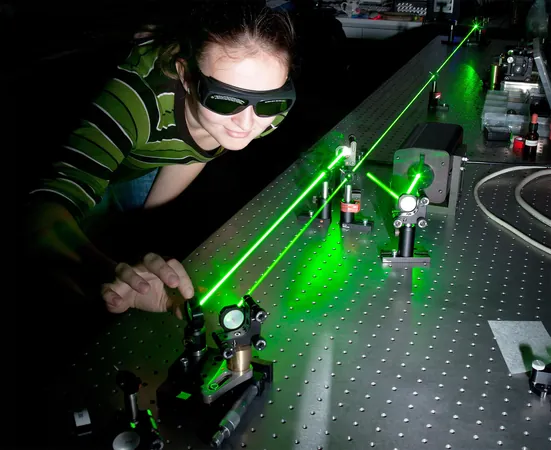
Scientists Discover Bizarre 'Negative Time' Phenomenon in Groundbreaking Experiment
2025-08-19
Author: William
In an astonishing twist that feels ripped from the pages of science fiction, researchers from the University of Toronto have delved into the perplexing realm of quantum physics, revealing that light can interact with atoms in a way that suggests it actually spends negative time doing so. Yes, you heard that right—negative time!
Imagine a stadium crowd synchronizing a wave: as people stand and sit in unison, the wave travels faster than any individual. Similarly, during this experiment, light exhibited remarkable behavior as it passed through rubidium atoms.
The Mind-Bending Experiment
Ordinarily, light slows down when it traverses materials—a textbook rule of physics. But the researchers used ultra-brief pulses of light, creating conditions where the peak of a light wave emerged from a material prematurely. While this elusive behavior has been observed before, it had been dismissed as an optical illusion—until now.
The pioneering team, led by professor Aephraim Steinberg and his colleague Daniela Angulo, cooled rubidium atoms to nearly absolute zero and fired incredibly weak light pulses through them—so weak that they could actually track individual photons.
Unraveling the Mystery of Negative Time
When a photon journeyed through the atoms, a probe beam detected subtle fluctuations. Astonishingly, these changes indicated that the atoms remained excited for a duration that sometimes registered as negative time. Steinberg described this perplexing finding: "That time turned out to be negative."
As light pulses experience what physicists refer to as negative group delay, exiting early, the atoms displayed corresponding phenomena of negative excitation times—enabling scientists to validate that this was not merely an optical illusion.
What Does Negative Time Really Mean?
Before anyone considers time travel, it’s crucial to clarify: the speed of light is unchanged. Steinberg commented, "We don’t want to say anything traveled backward in time; that’s a misinterpretation." Instead, when mixtures of frequencies within light pulses strike resonant atoms, each frequency is altered slightly. This reshaping results in a perception where the pulse peak seems to precede its expected position.
The atoms essentially capture this phenomenon, echoing the reshaping process and creating what can be measured as a negative interaction time. This bizarre but tangible occurrence exemplifies the oddities of quantum mechanics without violating its fundamental rules.
Why This Discovery Is a Big Deal
This breakthrough settles a longstanding debate among physicists regarding whether negative group delay was pure mathematical trickery or indicative of a genuine physical reality. The precision involved in the experiment was astounding; the team trapped rubidium-85 atoms in a minuscule cloud and sent intricately shaped signal pulses through them while monitoring with a probe beam traveling in the opposite direction.
By analyzing the correlation between probe signal changes and single-photon detections, they isolated effects from individual photons, consistently affirming predictions across various experimental scenarios.
Implications for Quantum Technology
Beyond academic curiosity, this discovery has significant implications for the future of quantum technology. Accurate control over photon-atom interactions is essential for developing advanced quantum computers and networks. Understanding these quirky timing effects, including the concept of negative time, could pave the way for refining these systems.
Looking Ahead
While the findings may stir skepticism, Steinberg noted that no one has disputed their experimental outcomes. As for immediate applications, he remained realistic: "I’ll be honest, I don’t currently have a path from what we’ve been looking at toward applications. We’re going to keep thinking about it, but I don’t want to get people’s hopes up."
Nonetheless, this study opens up new avenues for exploring quantum effects, and as history suggests, the most outlandish discoveries can spur groundbreaking advancements. This isn’t just a theoretical concept—negative time is now understood to be measurable and, intriguingly, entirely consistent with the laws of physics.
The full study was published in the journal arXiv, promising to continue the dialogue in the remarkable field of quantum physics.









 Brasil (PT)
Brasil (PT)
 Canada (EN)
Canada (EN)
 Chile (ES)
Chile (ES)
 Česko (CS)
Česko (CS)
 대한민국 (KO)
대한민국 (KO)
 España (ES)
España (ES)
 France (FR)
France (FR)
 Hong Kong (EN)
Hong Kong (EN)
 Italia (IT)
Italia (IT)
 日本 (JA)
日本 (JA)
 Magyarország (HU)
Magyarország (HU)
 Norge (NO)
Norge (NO)
 Polska (PL)
Polska (PL)
 Schweiz (DE)
Schweiz (DE)
 Singapore (EN)
Singapore (EN)
 Sverige (SV)
Sverige (SV)
 Suomi (FI)
Suomi (FI)
 Türkiye (TR)
Türkiye (TR)
 الإمارات العربية المتحدة (AR)
الإمارات العربية المتحدة (AR)